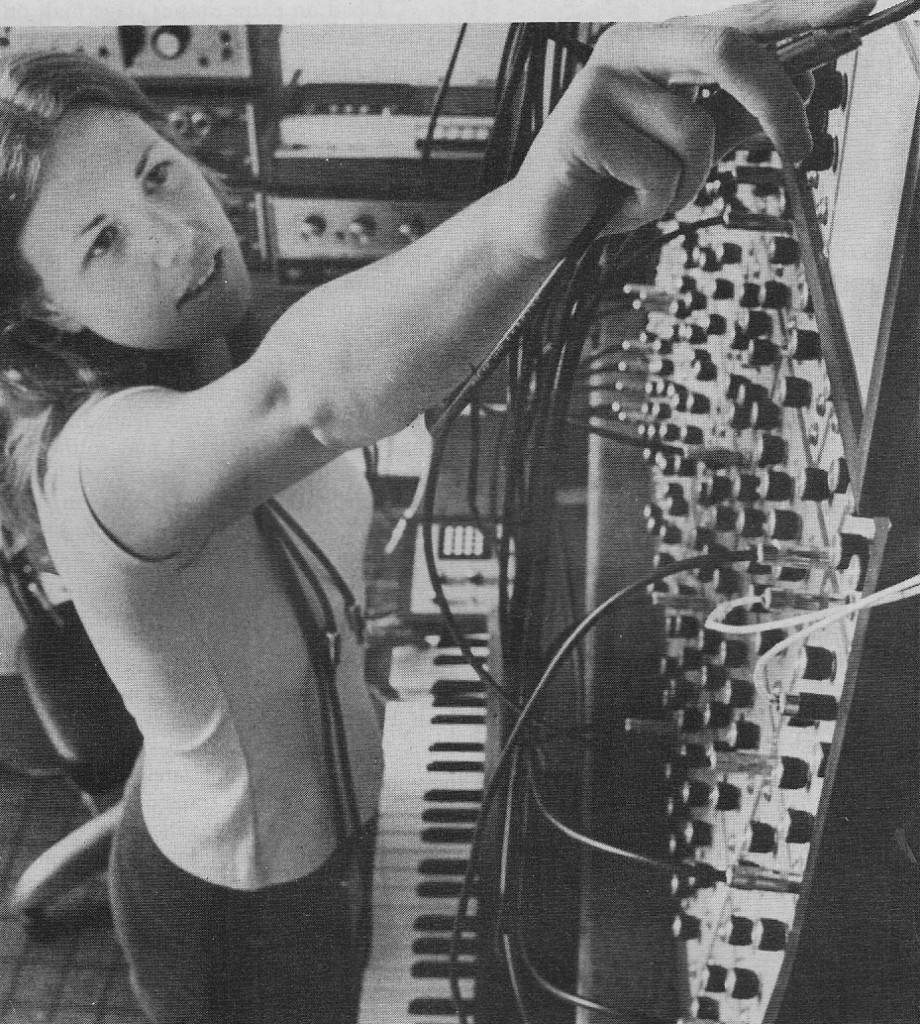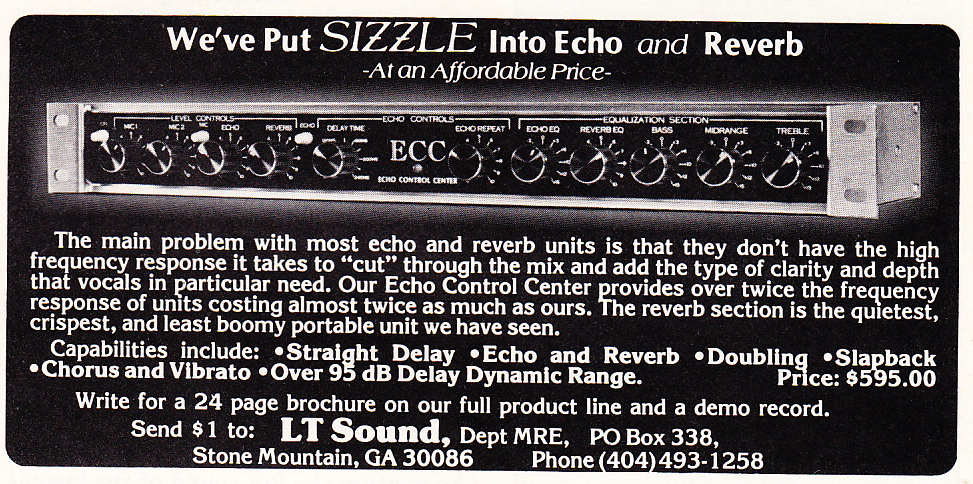Author: chris
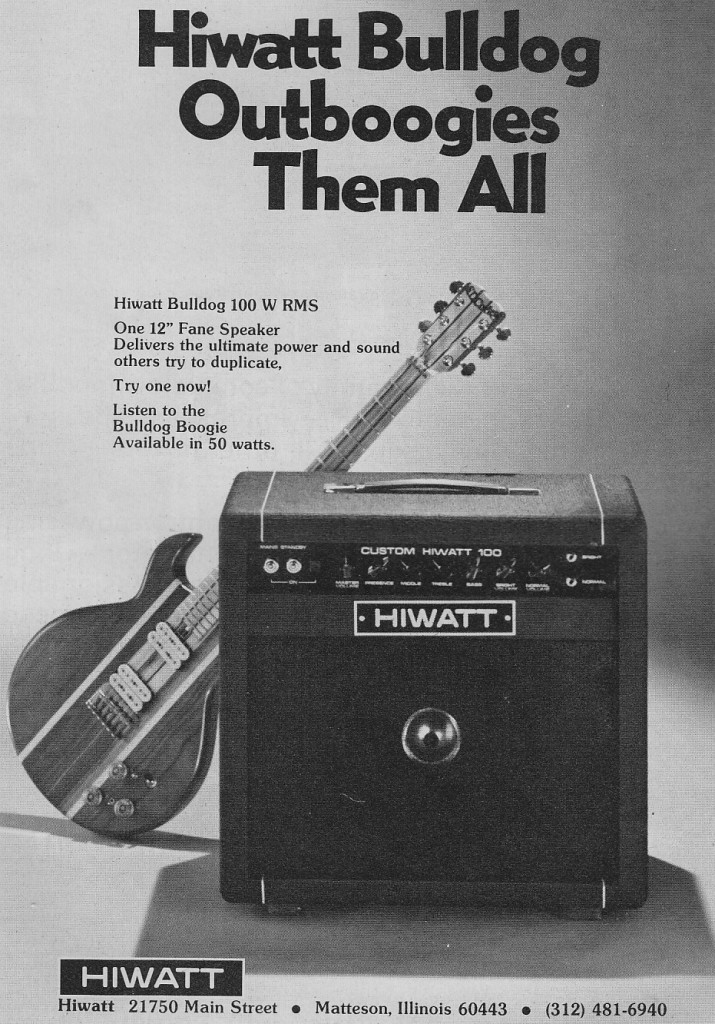 1978: The HIWATT 100-watt Bulldog combo amp offers a challenge to Mesa/Boogie in 1978. These must have been very rare; I can’t find a single one online. Read all about them at this link. The ‘mini-monster’ hi-powered-combo concept was introduced by Mesa/Boogie in the late 60s when Randall Smith modded a Fender Princeton by adding the power supply and output section from a Bassman, essentially making a little tiny (but heavy!) 50-watt combo amp. Curious about exactly how much of a ‘feat’ this was, I actually did this very thing many years ago to my brother’s Silverface Princeton. A decade on, the thing is still cooking. The perfect ‘vintage’ amp for NYC, or any city where you’ve gotta share a taxi to the gig!
1978: The HIWATT 100-watt Bulldog combo amp offers a challenge to Mesa/Boogie in 1978. These must have been very rare; I can’t find a single one online. Read all about them at this link. The ‘mini-monster’ hi-powered-combo concept was introduced by Mesa/Boogie in the late 60s when Randall Smith modded a Fender Princeton by adding the power supply and output section from a Bassman, essentially making a little tiny (but heavy!) 50-watt combo amp. Curious about exactly how much of a ‘feat’ this was, I actually did this very thing many years ago to my brother’s Silverface Princeton. A decade on, the thing is still cooking. The perfect ‘vintage’ amp for NYC, or any city where you’ve gotta share a taxi to the gig!
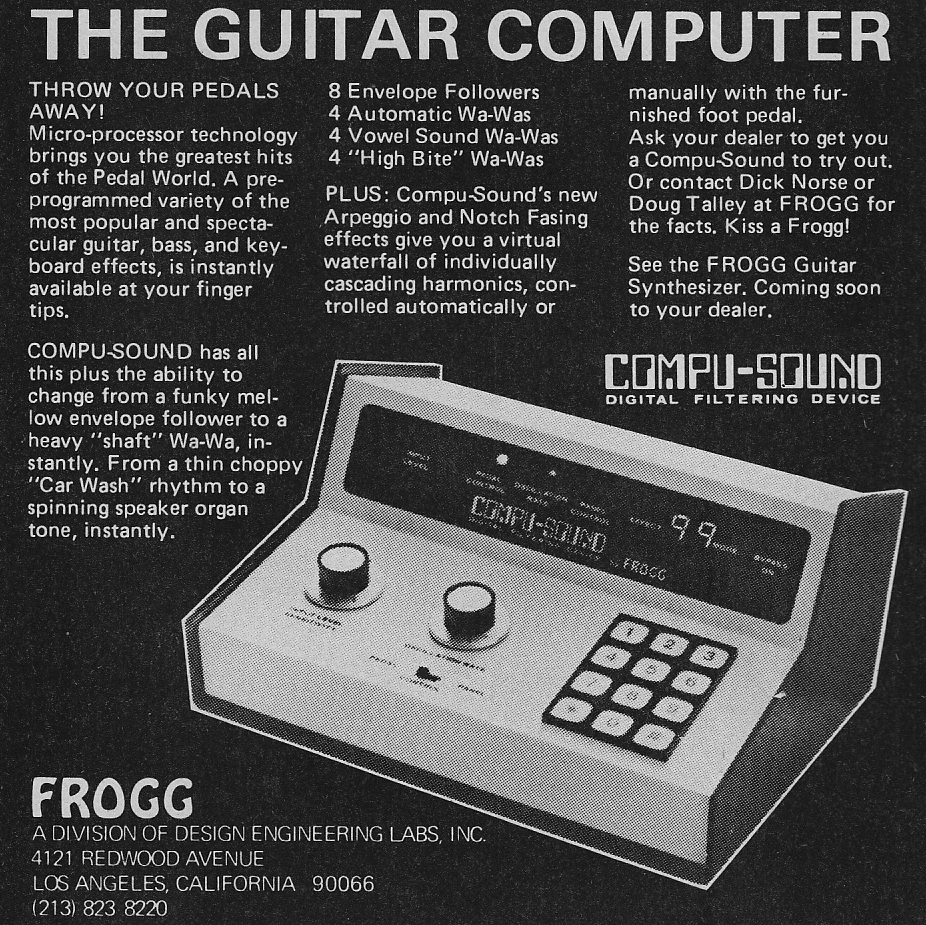 Holy WTF. Also, it’s basically a filter with an envelope follower. But WTF. Read all about at this dude’s website. Watch the video. And yea it sounds pretty neat. Only 100 ever made, apparently. And unsurprisingly. And goodnight.
Holy WTF. Also, it’s basically a filter with an envelope follower. But WTF. Read all about at this dude’s website. Watch the video. And yea it sounds pretty neat. Only 100 ever made, apparently. And unsurprisingly. And goodnight.
Polyfusion Advert c. 1979
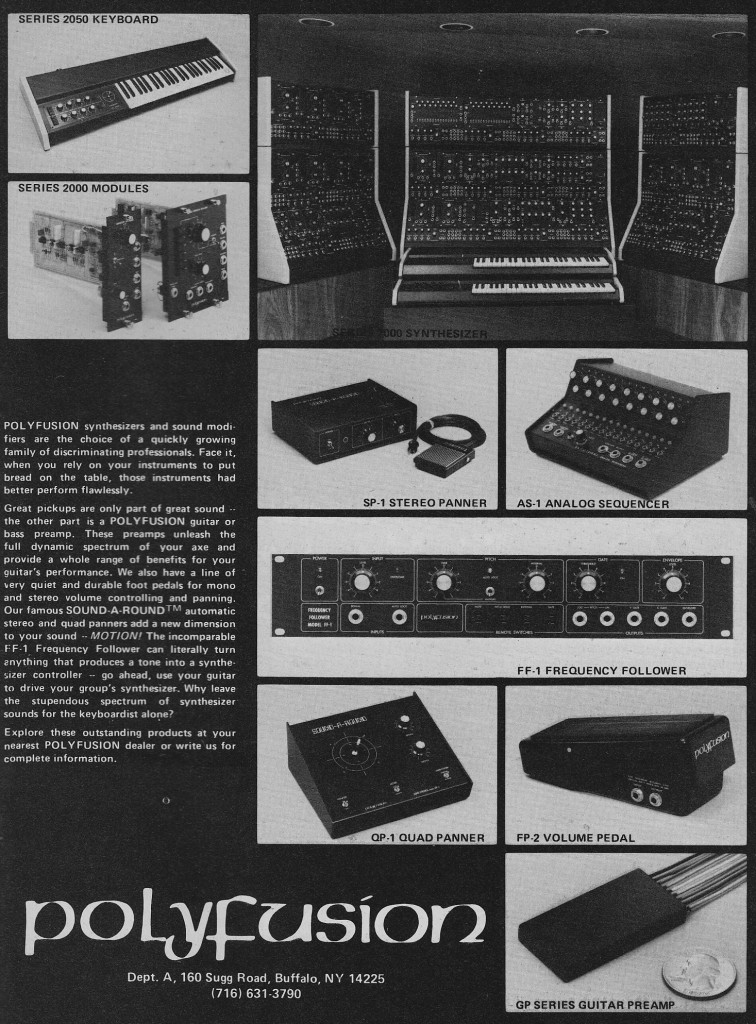 Several years ago I posted some of my collection of vintage Polyfusion documentation. Although Polyfusion did frequently run small adverts in trade publications, I had never seen this full-page advert before. Apparently, P/F also made guitar and bass preamps. Wild, man. Any Polyfusion users out there? Drop us a line!
Several years ago I posted some of my collection of vintage Polyfusion documentation. Although Polyfusion did frequently run small adverts in trade publications, I had never seen this full-page advert before. Apparently, P/F also made guitar and bass preamps. Wild, man. Any Polyfusion users out there? Drop us a line!
Small And Hot (1978)
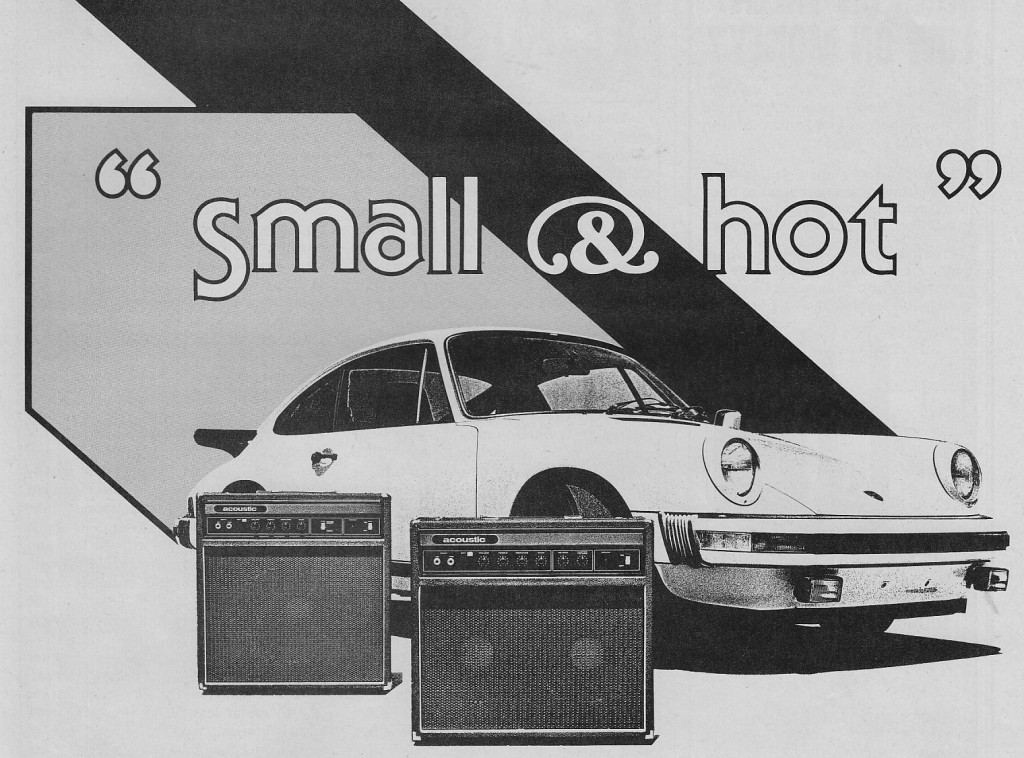 “Acoustic”-brand Amplifiers advert c. 1978. What was I saying the other day about “stick a Porsche next to pretty much anything?”
“Acoustic”-brand Amplifiers advert c. 1978. What was I saying the other day about “stick a Porsche next to pretty much anything?”
“The 911 can trace its roots back to sketches drawn by Ferdinand “Butzi” Porsche in 1959.[6] The Porsche 911 classic was developed as a much more powerful, larger, more comfortable replacement for the Porsche 356, the company’s first model. The new car made its public debut at the 1963[1] Frankfurt Motor Show (German: Internationale Automobil-Ausstellung).[7] The car presented at the auto show had a non-operational mockup of the 901 engine, receiving a working one in February 1964.[6]
It originally was designated as the “Porsche 901” (901 being its internal project number). 82 cars were built as 901s.[6] However, Peugeot protested on the grounds that in France it had exclusive rights to car names formed by three numbers with a zero in the middle. So, instead of selling the new model with another name in France, Porsche changed the name to 911. Internally, the cars’ part numbers carried on the prefix 901 for years.[6] Production began in September 1964,[7] the first 911s reached the US in February 1965 with a price tag of US$6,500.[6]” (SOURCE)
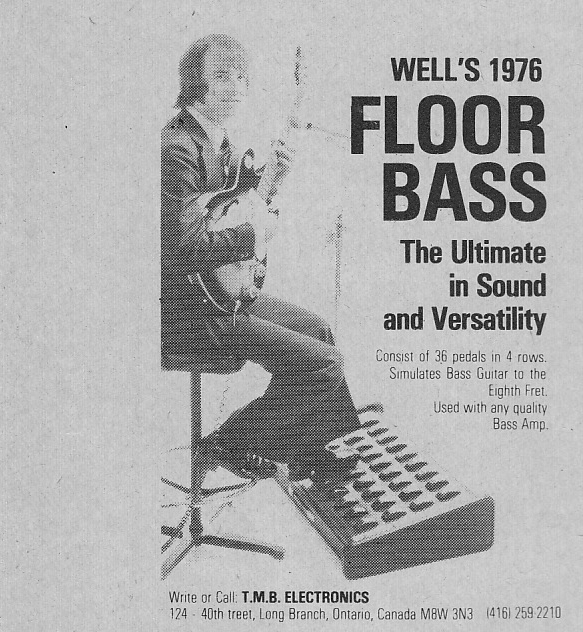 How y’all doin out there in the internets… had a pretty good AM at the F.M., having a George Crumb marathon on the ole’ 1500 right now, man is my wife ever patient. Anyhow, managed to find a pile of old 70’s musician mags that I was lacking, here are some weird+wild highlights of those that faded, those who never made the grade…
How y’all doin out there in the internets… had a pretty good AM at the F.M., having a George Crumb marathon on the ole’ 1500 right now, man is my wife ever patient. Anyhow, managed to find a pile of old 70’s musician mags that I was lacking, here are some weird+wild highlights of those that faded, those who never made the grade…
Starting out with: the TMB “Wells floor bass.” Holy shit this is cool. Unlike a Moog Taurus or the dozens of other ‘bass pedal synths’ out there, this unit was made with gtr-player-logic in mind. fkkn hell. Want it. Read more here!
The PS dot com AES 2013 report
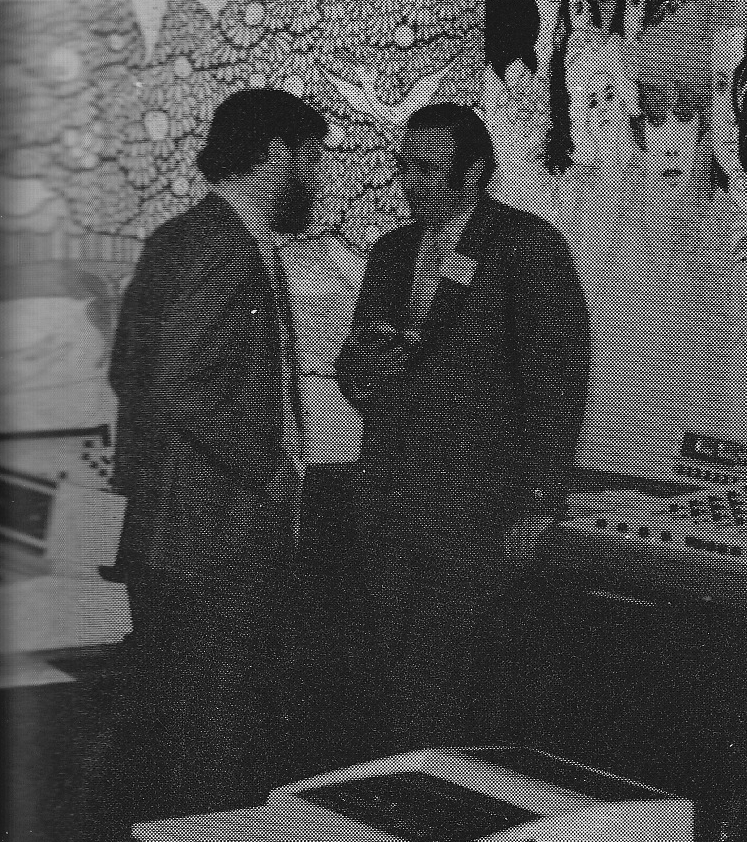 Above: Syl Butterworth tries to sell me more expensive stuff that I don’t need
Above: Syl Butterworth tries to sell me more expensive stuff that I don’t need
SO anyhow I went to the 2013 NY AES show, mainly to cover the DTV Broadcast Audio seminar for ProductionHub. You can read that article on their website. Before that hullabaloo took off, though, I had a couple of hours to walk the floor and take in the sights and sounds of a legion of soundbros (+ ettes) circling more fancy kit than you can shake a DA88 tape at. While I could probably write 500 pages on the offerings, I’m gonna limit this to a few assorted things that caught my eye, and highlight a few notable trends that I saw (or imagined; your call).
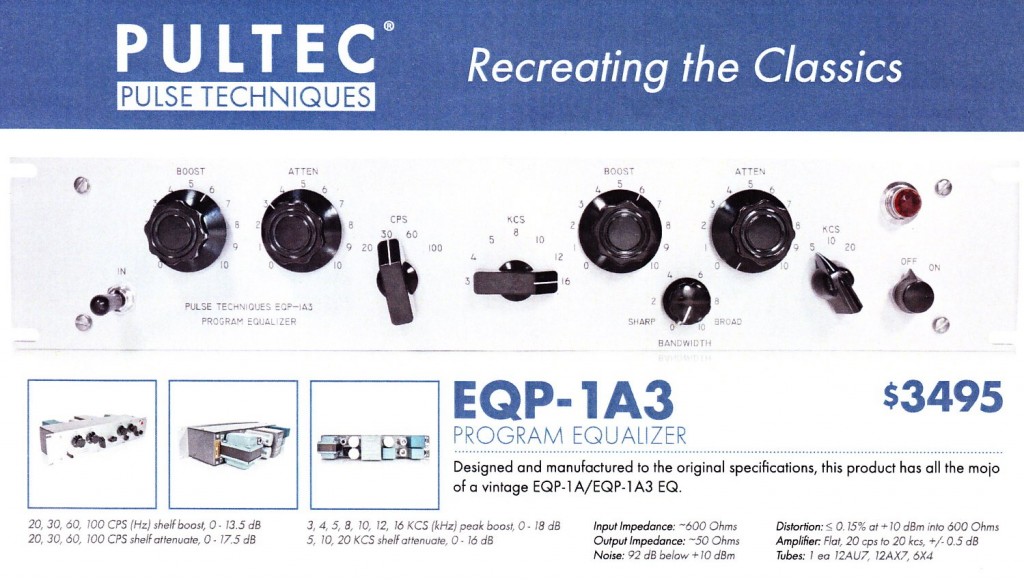 I got a chance to see the ‘New’ Pultecs in-the-chrome and talk for a minute with builder Steve Jackson. Suffice to say that Jackson has done an absolutely incredible job re-creating these things down to the frickin letter. The component-choice, layout, and lead-dress is so fanatically authentic; I’ve never seen such attention to detail. Jackson also had a prototype compressor on-hand that was a re-creation of an original Bob Fine design from the 1960s. Fine modified a Pultec MB-1, which is a feedback-controlled tube mic pre, to function as a compressor by adding some sort of solid-state control system. Jackson has re-created this device and may offer a production unit for sale at some point.
I got a chance to see the ‘New’ Pultecs in-the-chrome and talk for a minute with builder Steve Jackson. Suffice to say that Jackson has done an absolutely incredible job re-creating these things down to the frickin letter. The component-choice, layout, and lead-dress is so fanatically authentic; I’ve never seen such attention to detail. Jackson also had a prototype compressor on-hand that was a re-creation of an original Bob Fine design from the 1960s. Fine modified a Pultec MB-1, which is a feedback-controlled tube mic pre, to function as a compressor by adding some sort of solid-state control system. Jackson has re-created this device and may offer a production unit for sale at some point.
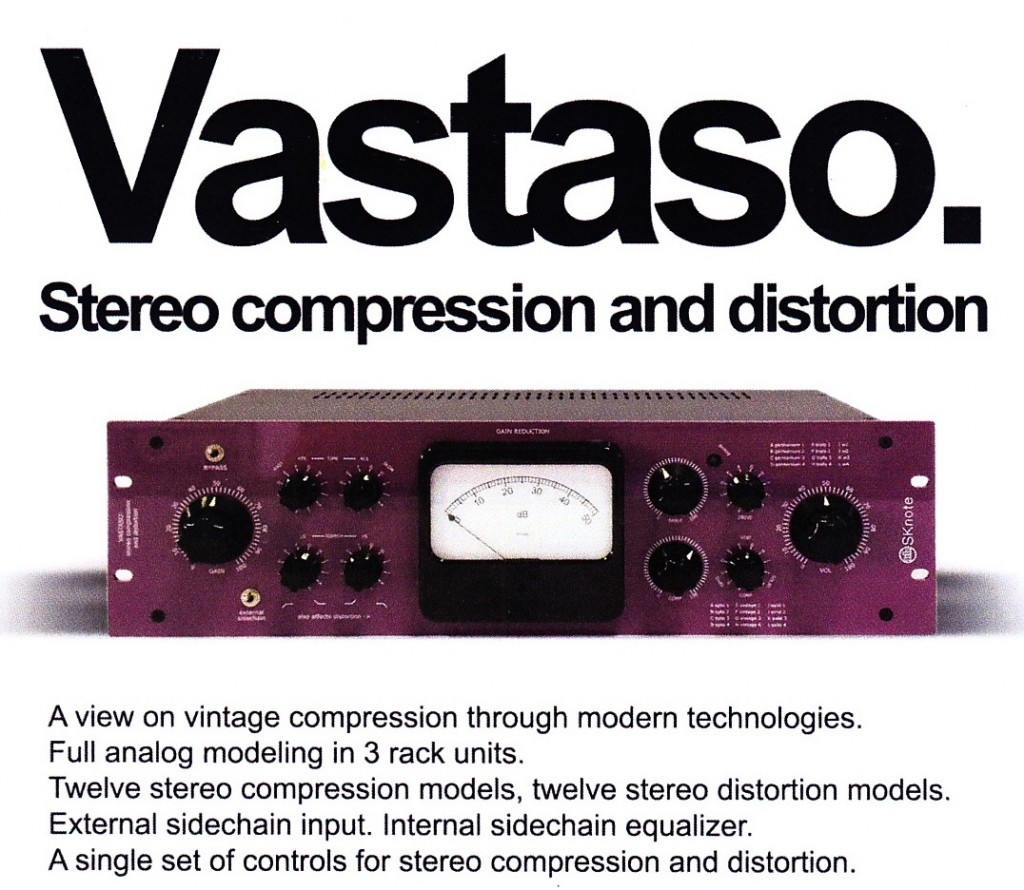 Above, the SKnote Vastaso, an analog-modelling stereo compressor/distortion unit of unique design. Looks like fun. No further comment.
Above, the SKnote Vastaso, an analog-modelling stereo compressor/distortion unit of unique design. Looks like fun. No further comment.
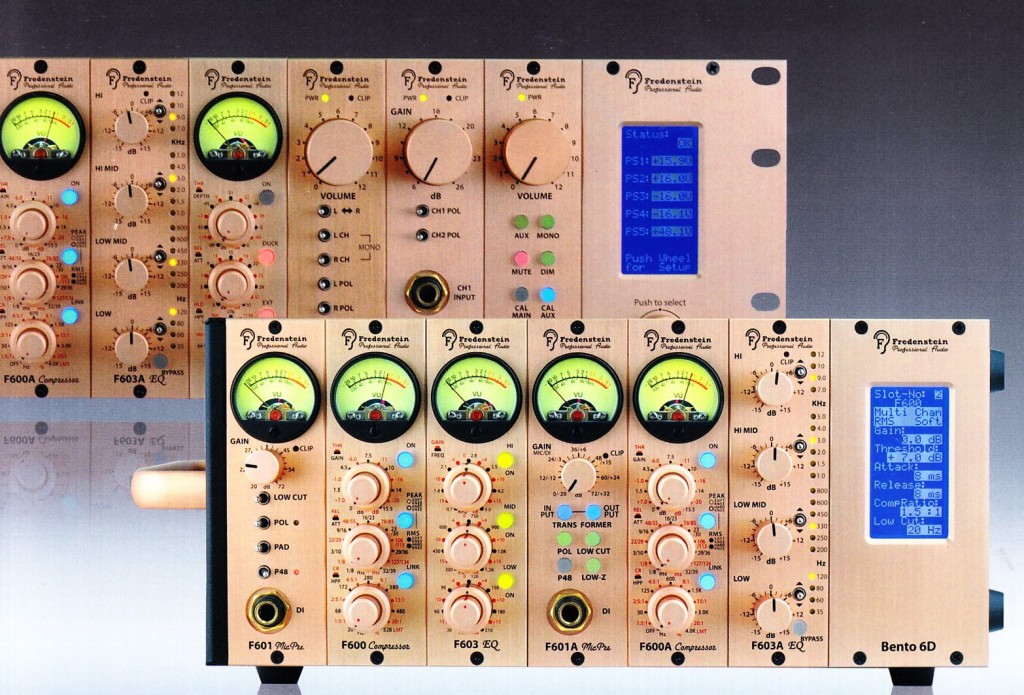 Fredenstein displayed their ‘600’ series of 500-compatible modules, as well as a novel stereo compressor and mic preamp. A Taiwanese firm, their design philosophy seems to be: all analog signal-path with all digital control. Seems like a fine idea to me. The units offer a wealth of unique features, and are available for surprisingly low prices from this dude on eBay.
Fredenstein displayed their ‘600’ series of 500-compatible modules, as well as a novel stereo compressor and mic preamp. A Taiwanese firm, their design philosophy seems to be: all analog signal-path with all digital control. Seems like a fine idea to me. The units offer a wealth of unique features, and are available for surprisingly low prices from this dude on eBay.
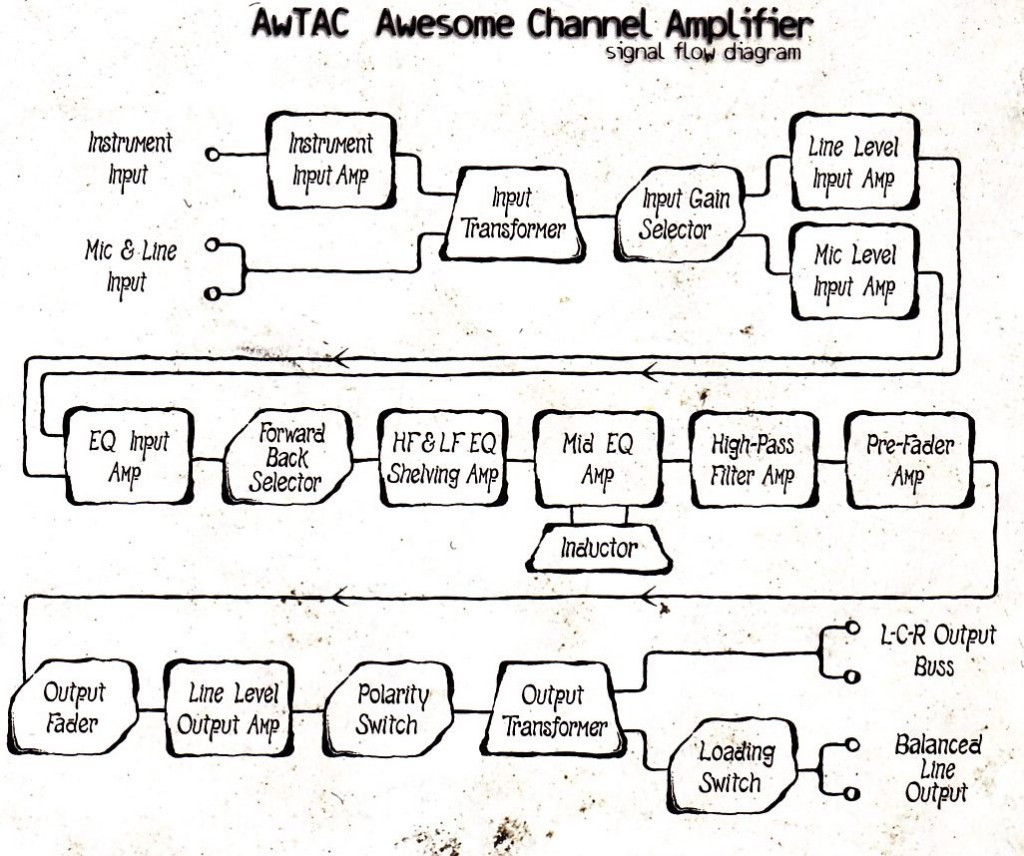 Brooklyn-based operation Awesome Transistor Amplifier Co. was demo’ing their ‘Awesome Channel Amplifier,’ which is a fairly unique product offering; this double-wide 500 module goes aggressively against the grain with a ‘more-is-more’ approach to gain staging; the concept, which is intriguing, is that ‘back in the day,’ it was not common to put a mic-pre right into a tape machine; most signals were recorded through a dozen or more stages, each of which naturally colors the signal somewhat. So, want that 70’s sound? If so, yr probably not gonna get it by plugging a 70’s mic pre right into yr convertors. AWTAC has brought the complexity of a vintage hi-end 70’s console signal-path into your 500 rack. But without all the maintenance hassles that go along with a big ole board. Multiple AwesChanAmps can also mix together through their bespoke panner modules and external faders, so it is possible to make an actual complete mixing system out of these things.
Brooklyn-based operation Awesome Transistor Amplifier Co. was demo’ing their ‘Awesome Channel Amplifier,’ which is a fairly unique product offering; this double-wide 500 module goes aggressively against the grain with a ‘more-is-more’ approach to gain staging; the concept, which is intriguing, is that ‘back in the day,’ it was not common to put a mic-pre right into a tape machine; most signals were recorded through a dozen or more stages, each of which naturally colors the signal somewhat. So, want that 70’s sound? If so, yr probably not gonna get it by plugging a 70’s mic pre right into yr convertors. AWTAC has brought the complexity of a vintage hi-end 70’s console signal-path into your 500 rack. But without all the maintenance hassles that go along with a big ole board. Multiple AwesChanAmps can also mix together through their bespoke panner modules and external faders, so it is possible to make an actual complete mixing system out of these things.
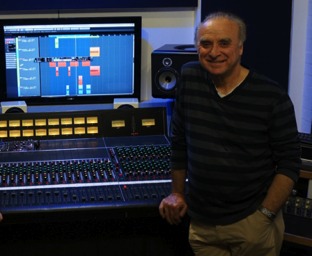 I got to talk with Malcolm Toft, father of Trident, for a minute; Toft was demo’ing his new Ocean-Audio branded ARK 516 console, which I think could be the best bang-for-the-buck new console going. For $20K, you get a perfectly viable 16-channel, 48 (??) input line-level board with lots of metering and features; it has no mic pres, compressors, or EQs, but each channel has two 500-series slots, so you can add whatever you want, whenever you want to! A 16-channel Speck Lilo was my ‘dream’ summing mixer for many years, but I may have to revise that now. This is a truly great concept that I hope does well for Toft.
I got to talk with Malcolm Toft, father of Trident, for a minute; Toft was demo’ing his new Ocean-Audio branded ARK 516 console, which I think could be the best bang-for-the-buck new console going. For $20K, you get a perfectly viable 16-channel, 48 (??) input line-level board with lots of metering and features; it has no mic pres, compressors, or EQs, but each channel has two 500-series slots, so you can add whatever you want, whenever you want to! A 16-channel Speck Lilo was my ‘dream’ summing mixer for many years, but I may have to revise that now. This is a truly great concept that I hope does well for Toft.
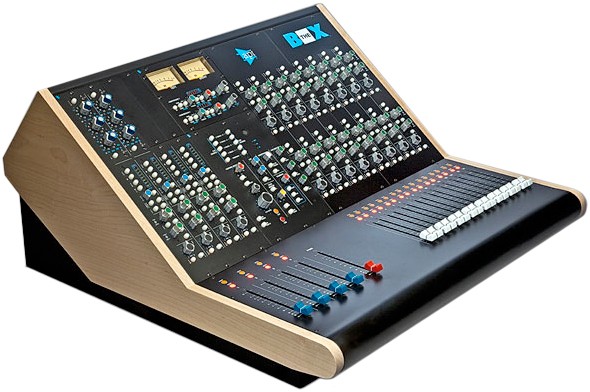 For home studios, EDM production, or just anyone who doesn’t need to track a lot of sources at once, the new API “The Box” is a tremendous value at $18k. You can read all about it at Vintage King.
For home studios, EDM production, or just anyone who doesn’t need to track a lot of sources at once, the new API “The Box” is a tremendous value at $18k. You can read all about it at Vintage King.
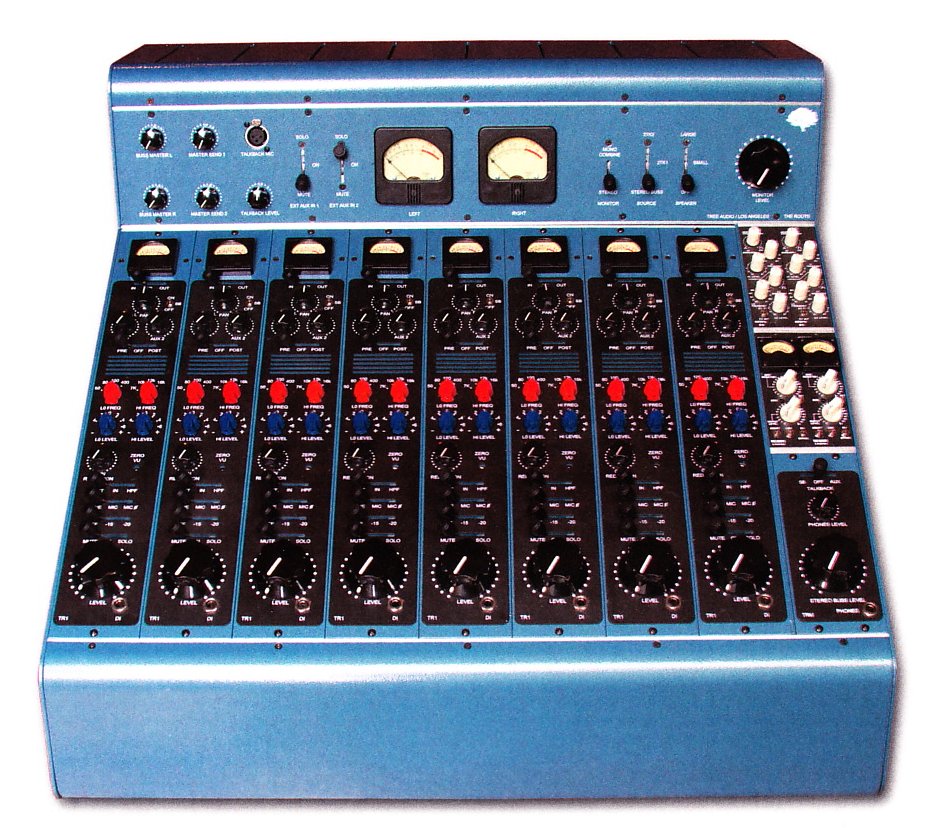 I’ve mentioned the Tree Audio ‘Roots’ console here before, but seeing it in-person confirmed that this is, potentially, an incredible deal for $22k. Eight input channels, each all-tube, with mic amps, variable shelving EQ, and compressors. Amazing. Plus you get a console master section with four 500-series slots for mix-buss processing. Now, I say “potentially great deal” because I couldn’t get a chance to actually listen to the thing, but if all works as it should, it is a real feat to be able to offer all this for $22k street. Just consider what you might expect to spend on 8 tube mic pres w/EQ, 8 tube compressors, and a nice summing mixer and master section.
I’ve mentioned the Tree Audio ‘Roots’ console here before, but seeing it in-person confirmed that this is, potentially, an incredible deal for $22k. Eight input channels, each all-tube, with mic amps, variable shelving EQ, and compressors. Amazing. Plus you get a console master section with four 500-series slots for mix-buss processing. Now, I say “potentially great deal” because I couldn’t get a chance to actually listen to the thing, but if all works as it should, it is a real feat to be able to offer all this for $22k street. Just consider what you might expect to spend on 8 tube mic pres w/EQ, 8 tube compressors, and a nice summing mixer and master section.
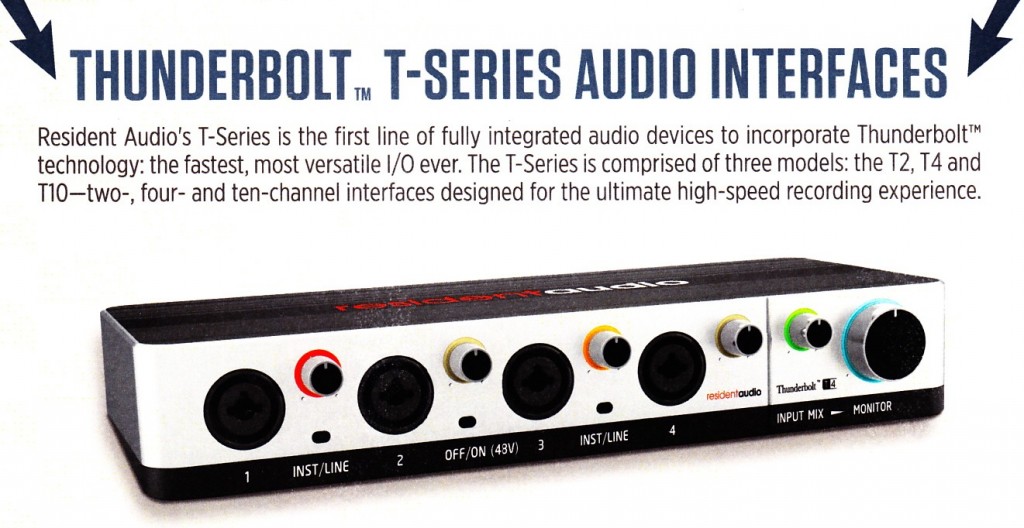 On the drier-but-essential end of the spectrum, Resident Audio unveiled a line of compact audio-interfaces of unusually high quality. As (apparently???) the first Thunderbolt interfaces, they can offer much more speed and higher-voltage analog circuits than traditional USB or Firewire units. Best of all: the 4×4-channel unit features a ‘BLEND’ knob for no-latency tracking. SADLY,,,, it does not have a spdif input! I really depend on the spdif input of my MBox2 for home-studio tasks since I track through an Apogee Mini-Me at home. Maybe you guys will re-consider and add some Digital I/O to these units…
On the drier-but-essential end of the spectrum, Resident Audio unveiled a line of compact audio-interfaces of unusually high quality. As (apparently???) the first Thunderbolt interfaces, they can offer much more speed and higher-voltage analog circuits than traditional USB or Firewire units. Best of all: the 4×4-channel unit features a ‘BLEND’ knob for no-latency tracking. SADLY,,,, it does not have a spdif input! I really depend on the spdif input of my MBox2 for home-studio tasks since I track through an Apogee Mini-Me at home. Maybe you guys will re-consider and add some Digital I/O to these units…
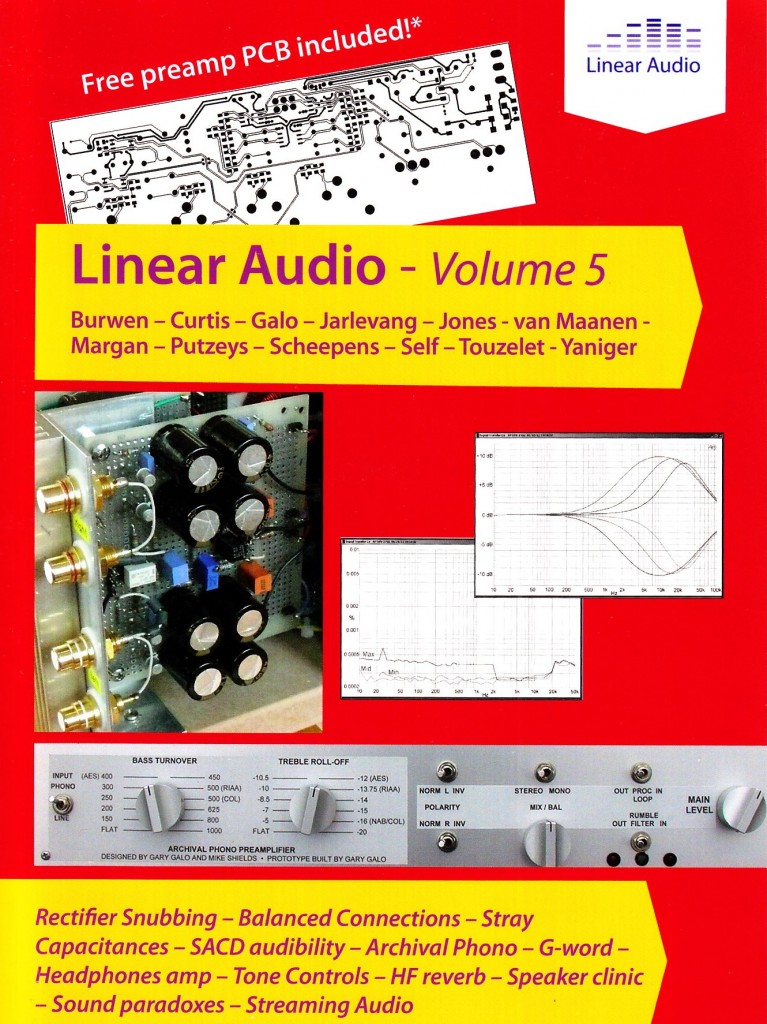 And last but not least, I picked up another issue of Linear Audio magazine. For all you DIY’rs out there, this is some serious stuff and I recommend that you check them out.
And last but not least, I picked up another issue of Linear Audio magazine. For all you DIY’rs out there, this is some serious stuff and I recommend that you check them out.
*************
*******
***
So, overall impressions? A few things: Each in their own ways, the AWTAC, Ocean Audio, Tree, and API offerings all confirm that there IS still interest in hardware mixers, and that designers are really addressing 21st century studio workflows to make ‘The Mixer” relevant to DAW production. I think that this is great.
Second, there is a continuing trend toward offering ‘weirder’ and ‘funkier’ front-end and mix-buss hardware. I think that, at this point, we all kinda agree that the best allocation of time and hardware-budget is to have a studio with a bunch of really signature input devices, some nice convertors, a reliable DAW, and then again some really signature mix-stem output-buss devices, with some sort of summing device to put it all together. As plug-ins and DAWs get better and better, there is less and less need for ‘proper’ EQs and compressors, and more and more need for colorful devices. Again, I think that this is a good thing, as it will encourage each studio, no matter how small, to be able to have some real ‘signature’ sounds. On the downside: being a studio tech in 30 years is gonna be MURDER, can you imagine? A fkkn million different little companies making TINY little 500 modules on tiny double-sided PCBs goddamn! Not fun. Let’s hope companies start making their service-data more readily available. Or something.
And finally, I am a bit both surprised and touched by the passion and dedication that so many of these small start-up manufacturers show in what is, really, a pretty dim future for recording studios. If there is anything that I have learned from writing OVER 600 (yup, no lie) articles on old sound equipment for this website, it’s that pro audio companies have a very, very, very high rate of business-failure. AND THAT WAS IN THE DAYS WHEN YOU COULD ACTUALLY SELL RECORDS! Nowadays: it’s terrifying. So when I walk the AES floor and see all these dudes with some weird and novel piece on display: I believe, I KNOW, that this has become an arena of passion + devotion; maybe a trade to the fortunate, but certainly an art to all who dare to try.
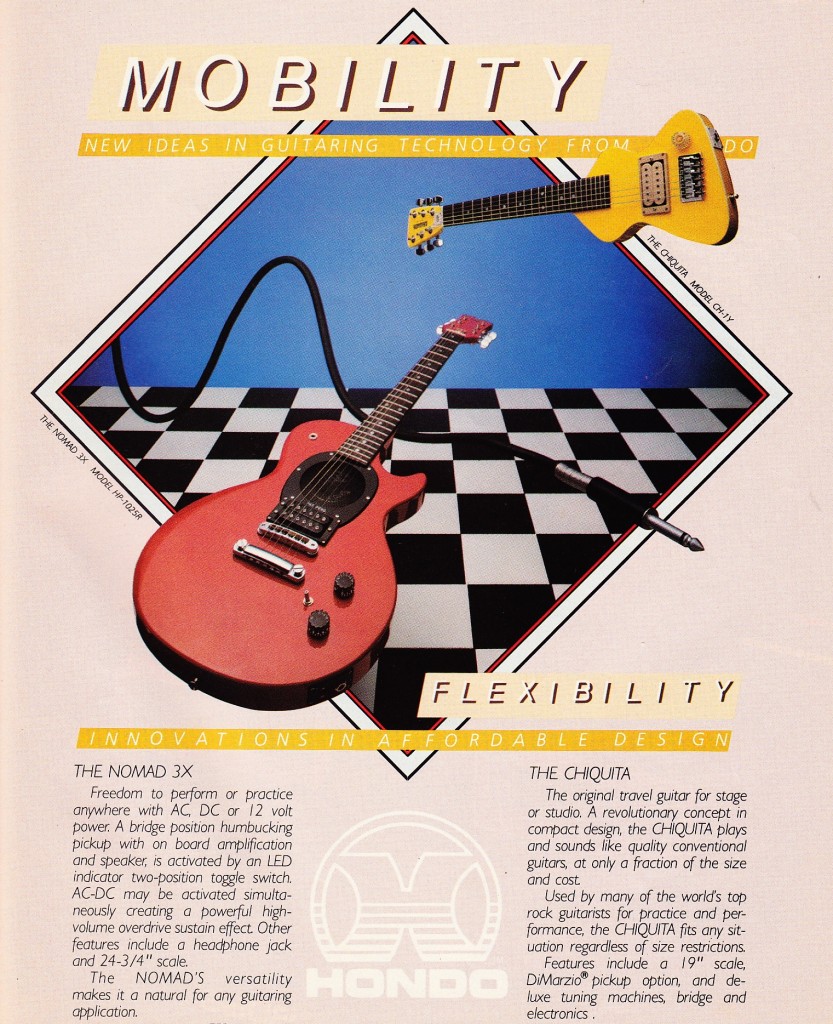 Above: many are familiar with “The Chiquita,” the ‘original (banana shaped/coloured) travel guitar’; less well-known is The Nomad 3X, a les-paul-jr-styled, full-scale guitar with a built-in-amp; it promises to operate from AC, DC, or 12 volt power. Okay… Anyhow, for previous HONDO coverage on PS dot com, click here… oh, and you prolly aughta click here, too…
Above: many are familiar with “The Chiquita,” the ‘original (banana shaped/coloured) travel guitar’; less well-known is The Nomad 3X, a les-paul-jr-styled, full-scale guitar with a built-in-amp; it promises to operate from AC, DC, or 12 volt power. Okay… Anyhow, for previous HONDO coverage on PS dot com, click here… oh, and you prolly aughta click here, too…
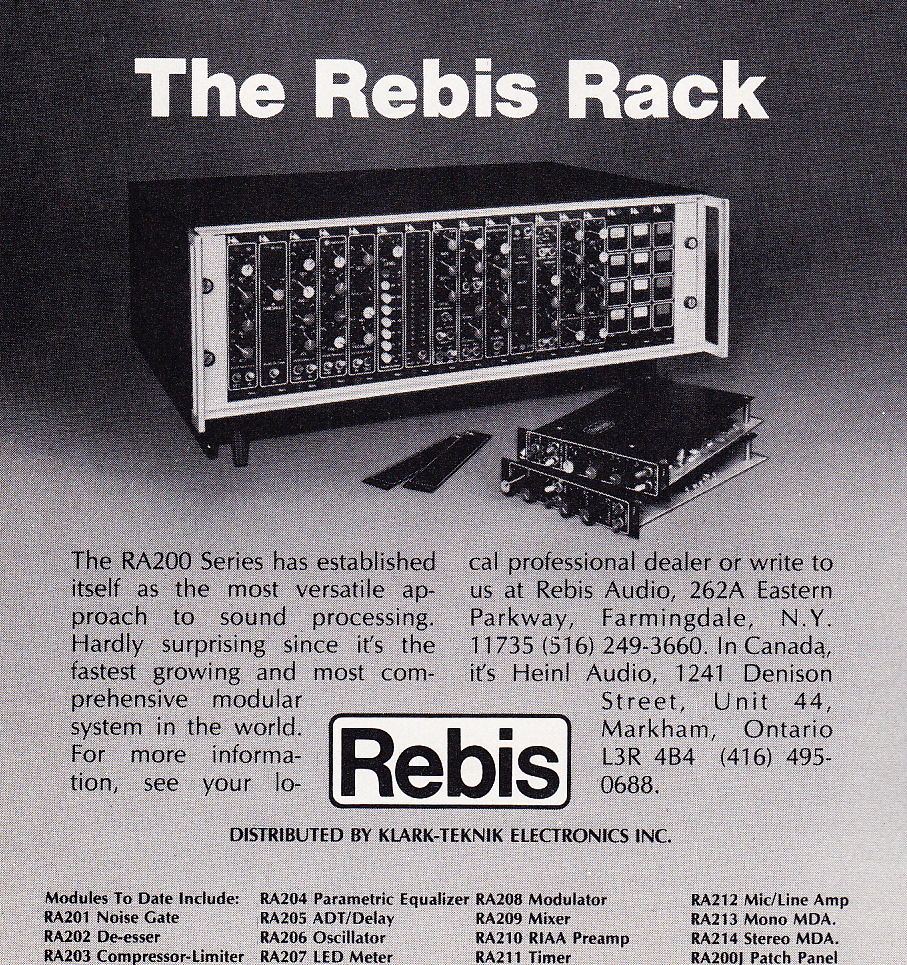 I was flipping thru some old pro audio mags and this REBIS (distributed by Klark-Teknik) advert caught my eye… I imagine that there must not be too many of these REBIS racks out there. I don’t think that I have ever come across any original REBIS documentation in the PS dot com archive, but i’ll give it another look…
I was flipping thru some old pro audio mags and this REBIS (distributed by Klark-Teknik) advert caught my eye… I imagine that there must not be too many of these REBIS racks out there. I don’t think that I have ever come across any original REBIS documentation in the PS dot com archive, but i’ll give it another look…
There is a very informative thread on GS regarding this line…
For our earlier coverage of the (earlier…) DBX 900 modules, click here…
And for our earlier coverage of the (earlier…) AD&R ‘Scamp’ modules, click here…
And for coverage of the 80’s Aphex module line, click here…
Any 80’s-era modular outboard I’ve missed fellas? Let us know…
